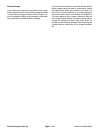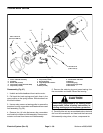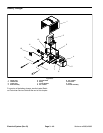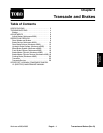
Workman e2050/e2065
Page 3 – 39
Electrical System (Rev. B)
Brush Service
1. Check the brush springs for correct alignment on the
back of the brush. A brush spring that does not apply
equal pressure on the center of the brush will cause the
brush to wear unevenly. Check for correct clearance and
freedom of brush movement in the holder.
2. Replace brushes that are worn to a length of 0.620”
(16 mm). Also, replace brushes if they show signs of un-
even wear or show signs of overheating, such as discol-
ored brush shunts and brush springs.
3. Brushes should always be replaced in complete sets
of eight. Use identical replacement parts; do not substi-
tute brush grades as the brushes are matched to the
motor type and application to provide the best service.
Substituting brushes of the wrong grade can cause pre-
mature commutator failure and excessive brush wear.
Remove old brushes and replace with identical replace-
ment parts. Hold brush shunts in position and torque
brush screws from 18 to 22 in–lbs (2 to 2.5 N–m) (Fig.
60). Make sure brushes move freely in the holders and
that shunts do not interfere with brush spring movement.
4. Make sure the brush box assembly is tight on the
commutator end head. Replace brush box assemblies
in the commutator end head if they are physically dam-
aged or brush holders are loose on the brush plate.
5. Brush springs should be checked for proper tension
using the following procedure (Fig. 59):
A. Place paper strip between brush face and com-
mutator. Hook spring scale as shown.
B. Pull spring scale on a line directly opposite the
line of force exerted by the brush spring. When the
paper strip begins to move freely, read the spring ten-
sion on the scale. Brush tension for a new brush
should be 65 ounces (1820 grams) and for a worn
brush should be 40 ounces (1120 grams).
Frame and Field Service
1. Motors that have been disassembled for servicing
should be given a complete inspection of the frame and
field assembly. If damage to the field coils or frame is
found, replace traction motor. Individual frame and field
components are not available.
2. Accumulated carbon dust, grease and other foreign
material can produce a ground path from the field wind-
ing to the frame. The frame and field should be cleaned
with Safety–Kleen 105 washing solvent or equivalent.
After cleaning, the frame and field must be oven–dried
for one hour at 300
o
F (148
o
C) to remove any cleaning
residue.
3. It is also recommended that the field be coated with
PD George 1000–70 or RanBar B–535–5S varnish for
proper insulation protection. Both recommended var-
nishes are Class H water–soluble varnishes. A similar
air–dry varnish may also be used providing it has a
Class H rating.
4. Screws securing the pole pieces to the frame should
be torqued from 250 to 300 in–lb (28.3 to 33.9 N–m) (Fig.
60).
1. Motor housing
2. Puller
3. Arbor press
Figure 58
1
2
3
1. Spring scale
2. Brush spring
3. Paper
Figure 59
1
2
3
1. Brush screw 2. Pole piece screw
Figure 60
2
2
1
Electrical
System


















